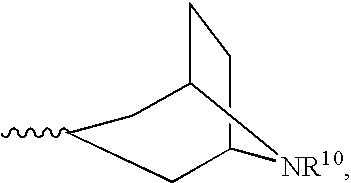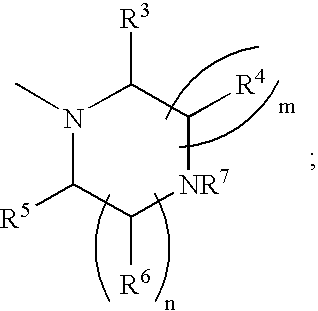Heterocyclic compounds
a heterocyclic compound and heterocyclic compound technology, applied in the field of new drugs, pharmaceutically active, fused heterocyclic compounds, can solve the problems of significantly less potency of -methylhistamine than histamin
- Summary
- Abstract
- Description
- Claims
- Application Information
AI Technical Summary
Benefits of technology
Problems solved by technology
Method used
Image
Examples
example 1
[0103]
(1H-Benzoimidazol-2-yl)-(4-methyl-piperazin-1-yl)-methanone
General Procedure 1:
[0104]A. 2-Trichloromethyl-1H-benzoimidazole. Methyl 2,2,2-trichloroacetimidate (1.63 mL, 9.22 mmol) was added to a solution of phenylenediamine (1.0 g, 9.2 mmol) in acetic acid (30 mL), which was then stirred at room temperature for 1 h. Water (20 mL) was added to the mixture, and the resultant precipitate was collected. The solid was washed with water (2×30 mL) and dried under vacuum to afford 1.90 g (88%) of 2-trichloromethyl-1H-benzoimidazole, which was used without further purification. MS (ESI): mass calculated for C8H5Cl3N2, 233.95; m / z found, 235.0 [M+H]+. 1HNMR (400 MHz, CDCl3): 13.45 (br s, 1H), 7.73-7.65 (m, 2H), 7.39-7.30 (m, 2H).
General Procedure 2:
[0105]B. (1H-Benzoimidazol-2-yl)-(4-methyl-piperazin-1-yl)-methanone. To a suspension of 2-trichloromethyl-1H-benzoimidazole (100 mg, 0.42 mmol) in 3:1 acetonitrile / water (4.0 mL) was added N-methylpiperazine (0.93 mL, 0.84 mmol) followed by ...
example 1 (
Alternative Preparation of Example 1 (Scheme 1)
[0106]A. Benzimidazole-2-carboxylic Acid. 2-Hydroxymethylbenzimidazole (6.75 mmol) was added to a flask containing hot water (25 mL). A 2 N Na2CO3 solution (5 mL) was added to the reaction mixture until it reached pH 10-12, followed by addition of KMnO4 (˜10 mmol). The reaction mixture was then allowed to reflux for 0.5 h. The hot solution was filtered, and the filtrate was cooled to room temperature and 3 N acetic acid was added until the pH reached 3-4. The resulting white precipitate was collected by filtration and rinsed with water and ether to obtain the title intermediate. MS (ESI): mass calculated for C8H6N2O2, 162.04; m / z found, 163.10 [M+H]+. 1H NMR (400 MHz, CD3OD): 7.61-7.55 (m, 2H), 7.44-7.38 (m, 2H).
[0107]B. (1H-Benzoimidazol-2-yl)-(4-methyl-piperazin-1-yl)-methanone. Diisopropylethylamine (2.2 mmol) was added to a solution of benzimidazole-2-carboxylic acid (3.59 mmol), O-(7-azabenzotriazol-1-yl)-N,N,N′,N′-tetramethyluroni...
example 2
[0108]
(1H-Benzoimidazol-2-yl)-(4-ethyl-piperazin-1-yl)-methanone
[0109]The reaction was carried out as described in General Procedure 2 using 2-trichloromethyl-1H-benzoimidazole (Example 1, 100 mg, 0.42 mmol) and N-ethylpiperazine (0.10 mL, 0.84 mmol). Purification afforded 16 mg (15%) of the title compound. MS (ESI): mass calculated for Cl14H18N4O, 258.15; m / z found, 259.2 [M+H]+. 1H NMR (400 MHz, CDCl3): 11.60 (br s, 1H), 7.82 (d, J=8.0 Hz, 1H), 7.54 (d, J=8.0 Hz, 1H), 7.35-7.30 (m, 2H), 4.82-4.80 (m, 2H), 3.97-3.95 (m, 2H), 2.63-2.59 (m, 4H), 2.48 (q, J=7.2 Hz, 2H), 1.14 (t, J=7.2 Hz, 3H).
PUM
| Property | Measurement | Unit |
|---|---|---|
| weight | aaaaa | aaaaa |
| weight | aaaaa | aaaaa |
| pressure | aaaaa | aaaaa |
Abstract
Description
Claims
Application Information
 Login to View More
Login to View More - R&D
- Intellectual Property
- Life Sciences
- Materials
- Tech Scout
- Unparalleled Data Quality
- Higher Quality Content
- 60% Fewer Hallucinations
Browse by: Latest US Patents, China's latest patents, Technical Efficacy Thesaurus, Application Domain, Technology Topic, Popular Technical Reports.
© 2025 PatSnap. All rights reserved.Legal|Privacy policy|Modern Slavery Act Transparency Statement|Sitemap|About US| Contact US: help@patsnap.com



